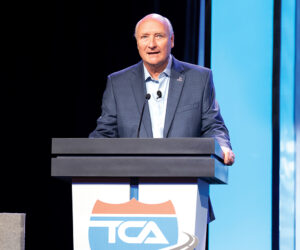WASHINGTON — The Federal Motor Carrier Safety Administration Tuesday said it is seeking public comment on a potential pilot program that would allow drivers ages 18-20 to operate commercial motor vehicles (CMVs) in interstate commerce.
“Commercial trucks and buses are essential to a thriving national economy, and the department wants to ensure the public has an opportunity to comment on this important potential change,” said U.S. Transportation Secretary Elaine L. Chao.
Drivers ages 18-20 may currently only operate CMVs in intrastate commerce.
In July 2018, USDOT announced the details of the Commercial Driver Pilot Program required under the Fixing America’s Surface Transportation (FAST) Act, which allows certain 18- to 20-year-olds with military training to operate CMVs in interstate commerce.
Tuesday’s action requests comments on a second pilot program to allow non-military drivers ages 18-20 to operate CMVs in interstate commerce.
FMCSA requests comments on the training, qualifications, driving limitations, and vehicle safety systems that FMCSA should consider in developing options or approaches for a second pilot program for younger drivers.
“We want input from the public on efforts that offer the potential to create more jobs in the commercial motor vehicle industry, while maintaining the highest level of safety. We encourage all CMV stakeholders to submit comments on a potential interstate pilot program for younger drivers,” said FMCSA Administrator Raymond P. Martinez.
Support for a pilot program among the general population dates back to October 2, 200, when the Truckload Carriers Association, petitioned the FMCSA to conduct a younger driver pilot program.
Motor carriers, truck driver training schools, a trade association and an insurance company joined in the petition asking FMCSA to authorize a pilot program to determine if CMV drivers under age 21 could operate CMVs safely in interstate commerce.
The petitioners said that this pilot would address the shortage of CMV drivers in the trucking industry. The petitioners also asserted that recruiting young persons as truck drivers would be easier if they could be approached immediately after graduation from high school.
In February 2001, the FMCSA published a notice requesting comments on the TCA petition and received 1,600 comments with more than 90 percent opposed, most of the basis that individuals under 21 lacked the maturity and judgment to operate a commercial motor vehicle and on June 9, 2003, the FMCSA denied the petition.
TCA still strongly supports a pilot program, said David Heller, vice president of government affairs at TCA.
His association believes the pilot study is crucial in determining the safety performance of younger drivers.
“If you look at interstate commerce, I can stand on top of TCA’s roof and look into D.C. and turn 90 degrees and look into Maryland, but if I’m a younger driver, I can’t drive into those areas,” Heller said, “but I can drive into the far southwest corner of Virginia, which in and of itself a long haul. In saying that, what is truly the line of demarcation. So once and for all let’s glean data to show and prove whether they can be safe. This is an effort to collect the data that can verify whether these drivers are as safe or safer in those magical words that truly matter. As safe or safer than their seasoned counterparts.”
Should in the end drivers under 21 be allowed to drive interstate, there would be a whole new demographic from which carriers could recruit.
Just because a new demographic opens up, it doesn’t mean carriers would naturally recruit from that pool, Heller said. recruit from that pool. \
“There are a lot of different things that go into that equation, insurance for one, that certainly play a major role in whether carriers will recruit from that demographic,” he said. “And just because we get the new demographic doesn’t mean they are going to like trucking.”
The American Trucking Association also supports the pilot program.
“ATA supports FMCSA’s efforts to expand on its current work examining younger commercial drivers,” said ATA President and CEO Chris Spear. “Right now, 18-, 19-, and 20-year-old drivers are driving trucks in the United States. What these pilot programs will do is set out a path for these drivers to fully participate in our industry by allowing them to drive interstate.
“Allowing younger drivers, who are already moving goods intrastate, to drive interstate is a common sense step that has support not just from the trucking industry, but from a broad coalition,” Spear said. “Between FMCSA’s opposed pilot project and the bipartisan support for the Drive SAFE Act in Congress, we hope we will soon create a path for more young people to fully participate in our industry.”
The Owner-Operator Independent Drivers Association in opposition to the second pilot program.
“Rather than developing ways to allow more teenagers behind the wheel of commercial trucks, the federal government should be taking steps to reverse the incessantly high driver turnover rate, which remains above 90 percent among large truckload carriers,” said Todd Spencer, president of OOIDA. “Efforts should focus on improving the industry instead of trying to hire more cheap labor.”
Spencer said OOIDA contends that younger drivers – especially teenagers – generally lack the maturity and experience to operate a CMV at the safest levels. Research has consistently shown that CMV drivers under 21 are more likely to be involved in crashes.
“Launching this pilot program would go against FMCSA’s goal of improving highway safety,” Spencer said. “The agency should not be used as a tool for large motor carriers to expand their driver pool instead of fixing the problems that have led to their extremely high turnover rates. “If highway safety is the priority, the age should go up, not down. Instead of efforts to entice the least experienced, the focus should be hiring and retaining the most experienced drivers, not expanding the funnel of driver churn.”
Lyndon Finney’s publishing career spans over 55 years beginning with a reporter position with the Southwest Times Record in Fort Smith, Arkansas, in 1965. Since then he’s been a newspaper editor at the Southwest Times Record, served five years as assistant managing editor of the Arkansas Democrat-Gazette in Little Rock and from November 2004 through December 2019 served as editor of The Trucker. Between newspaper jobs he spent 14 years as director of communications at Baptist Health, Arkansas’ largest healthcare system. In addition to his publishing career he served for 46 years as organist at Little Rock’s largest Baptist church.








